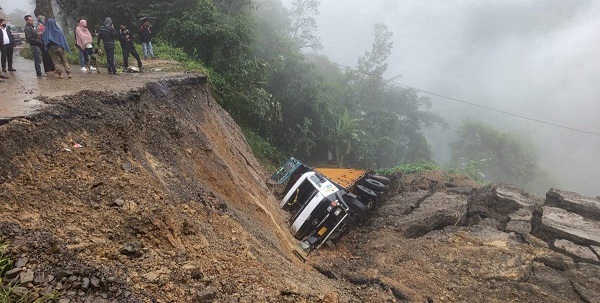Manipur Landslides

Recent Landslides in Manipur:
- On June 30th, landslides hit the Tupul area in the Noney district of Manipur.
- The landslide occurred at a railway construction site. It claimed the lives of some 25 people and several more remained trapped under debris.
- Even as the rescue attempts were underway, a 2nd landslide hit close to the 1st disaster site.
- As of July 3rd, the death toll was reported to be 42 people with some 20 more being missing.
- The rescue efforts are being complicated by heavy rains– given the monsoon season.
- Apart from this, the landslide debris are blocking the Ijei river. This has led to the water level rising significantly behind the debris, which has formed a dam like structure. There is now a high risk of this dam breaching and inundating the nearby low lying areas.
- Meanwhile, hundreds of vehicles, including loaded trucks and buses, are stranded on either side of the disaster site close to NH37.
- Notably, the current disaster site is in the vicinity of the epicentre of 6.7 magnitude earthquake that struck in 2016.
How have the authorities been responding?
- The authorities are undertaking measures to enable the outflow of this stored water. However, the efforts are being slowed down by the rains and the subsequent landslide.
- The Army, Territorial Army and Assam Rifles have been deployed in addition to the State Disaster Response Force and the National Disaster Response Force.
- The rescue teams are using Through Wall Imaging Radar technology to look for the missing persons under the debris.
- An advisory has been issued to warn the nearby village population to evacuate.
- People have been advised to leave vehicles on the highway and proceed to evacuate on foot. This is because these vehicles are impeding the rescue efforts.
Why is this incident cause for concern?
- The recent landslide is one of the severest natural disaster in the state.
- Considering the location of the landslide- a railway construction site in a landslide-prone zone- there is a concern over how development is being planned in the area.
- According to government data, Manipur has witnessed some 20 landslides between 2014 and 2020. This is not insignificant, even though most of the landslides in this period occurred in the Himalayan states and states like Kerala (with hilly/ ghat terrain).
- The Environment Ministry acknowledged that these landslides are man-made. According to the ministry, the recent landslides are “a result of modification of slopes for construction, widening of road, quarrying for construction materials, fragile lithography, complex geological structures and heavy rainfall”.
- The high casualty count is another cause for concern.
- Adding to this is the increasingly unpredictable monsoon pattern and the increasing frequency of extreme weather events.
What needs to be done?
- The current priority is to rescue the trapped individuals and mitigate the swelling river.
- As a post-facto exercise, the government needs to determine whether sufficient soil and stability tests were carried out before the area was chose for railway construction.
- According to researchers, the areas bordering national highways, in western Manipur, fall under moderate, high or even very high hazard zones.
- Notably, the government has been identifying landslide-prone areas, include Tupul, under the National Landslide Susceptibility Mapping project.
- The Geological Survey of India is developing an early warning system for landslides. These need to be quickly deployed in vulnerable states to help mitigate these disasters’ fallout.
Conclusion:
The northeastern states’ enthusiasm for accelerated connectivity projects is understandable, given the need to economically boost the region. However, disasters, like the Tupul landslides, highlight the dangers of ignoring ecological challenges stemming from activities like deforestation. The current incident is a wakeup call for the governments.
If you like this post, please share your feedback in the comments section below so that we will upload more posts like this.


